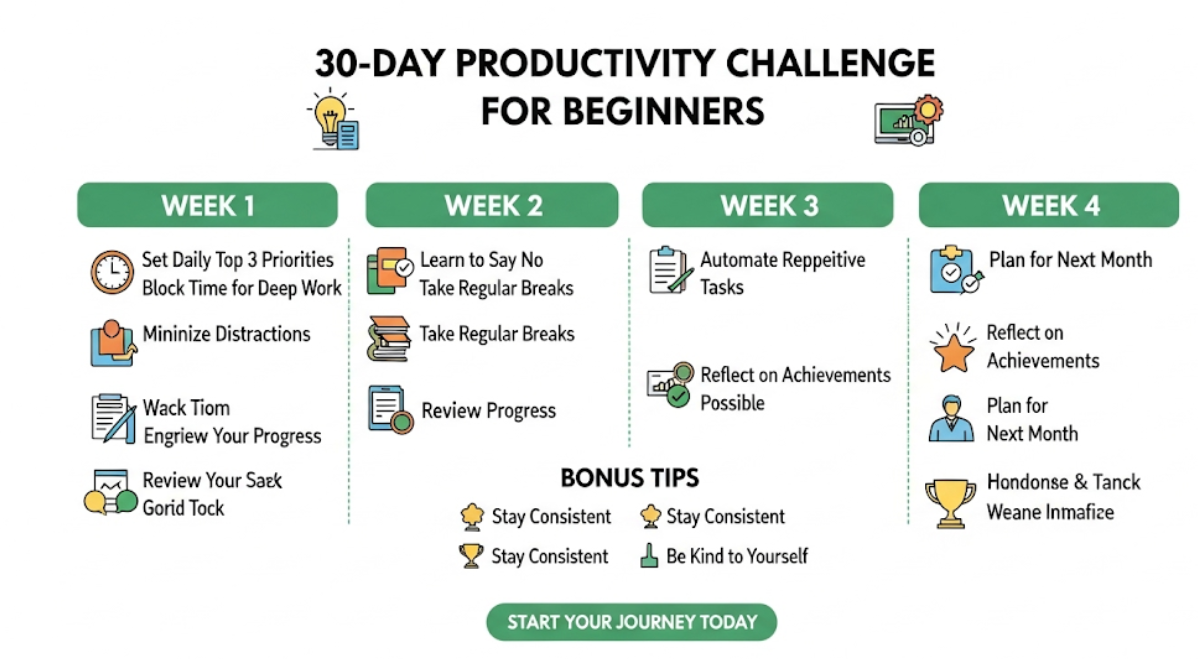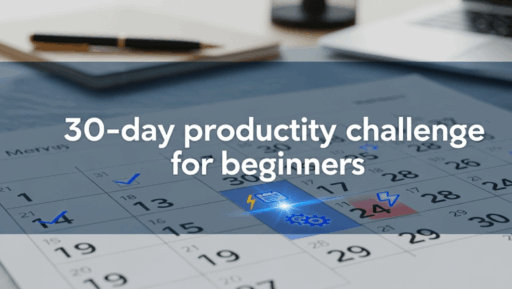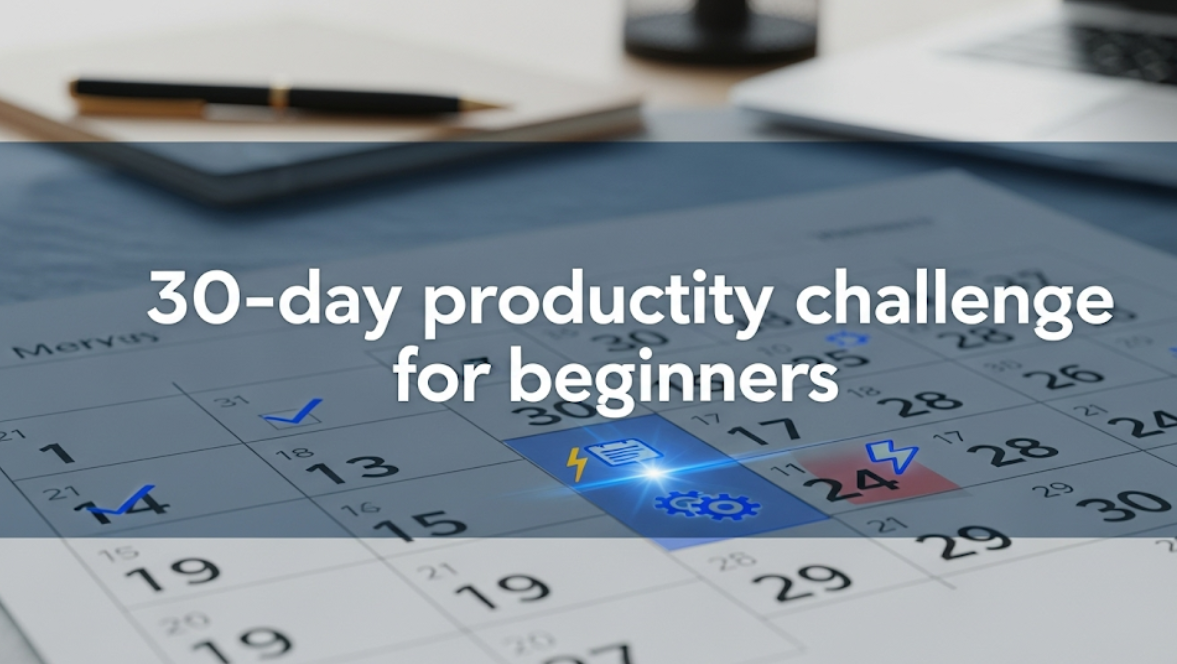Transform Everyday Productivity: A 30-Day Beginner’s Guide to Maximizing Your Routines
It does not have to be another stressful journey towards higher productivity. Whether you are a student trying to balance homework and social life, just got your first job, or if you want to have some more time for getting your entire wardrobe updated, practicing this structured 30-day productivity challenge can be ideal for establishing habits that stick around for long.
This complete guide takes you through a beginner day-by-day productivity plan. You will acquire useful strategies, dodge the pitfalls, and build practices that last far beyond the challenge. After the end of these 30 days, not only will you have changed how you work, but you will change how time and efficiency intersect in your thinking.
Why You Should Try a 30-Day Challenge Over a Quick Fix
So many people try to change everything at once and then the excitement fades away, a week later they are back to square one. The 30-day challenge, on the other hand, works by establishing one tiny habit at a time. Research indicates that it takes anywhere from 21 to 66 days for a new habit to stick, and 30 days is optimal in order to have any significant effect.
Time during which we can reclaim our own is what makes this time-frame unique. Thirty days sounds doable, but not daunting. It is lengthy enough for real results and short enough to sustain constant motivation during the whole time.
Benefits You’ll Experience
- Improved time management skills
- Better work-life balance
- Reduced stress and anxiety
- Increased energy levels
- Enhanced focus and concentration
- Greater sense of accomplishment
Week 1: Setting a Foundation (Days 1-7)
The focus this week is on setting habits that support your productivity in all areas. As mentioned before, this is like building a house—if the foundation isn’t solid, everything can crumble.
Day 1: Set Up Your Workspace for Productivity
More of your behavior is zone-based than you think. Whether it is a corner in the bedroom, somewhere on the kitchen table, or even a home office they can use alone.
Today’s Action Steps:
- Choose your designated work area
- Remove all distractions (food, games, or other outside decorations)
- Keep necessary supplies at hand
- Set up proper lighting
- Try out your setup for 30 minutes
Day 2: The Two-Minute Rule
If a task takes under two minutes to complete, get it done then and there, or you may never actually do it. This rule avoids the piling up of small tasks into a mountain of work.
Practice Examples:
- Reply to that text message
- File that document
- Wash your coffee cup
- Make your bed
- Write down tomorrow’s appointment
Day 3: Time Tracking Basics
You cannot manage what you do not measure. Today, count the time—not how you believe you’re spending your minutes. The results might surprise you.
How to Do It: Create a basic log with 30-minute blocks from when you wake up until bed. Write down what you worked on during each one. Do not judge—just notice and write down.
Day 4: The Miracle of Single-Tasking
Multitasking is a myth that decreases our efficiency by up to 40%! For today, just practice doing one thing at a time with your full attention.
Single-Tasking Techniques:
- Close all other tabs in your browser and keep the current tab open
- Put your phone on the edge of your bed instead of next to a charger at night
- Use a timer to create focused work periods
- Space between task categories
Day 5: Create a Morning Routine
Your morning routine sets the pace for your day. Establish a morning routine that gets you fired up and ready for the day ahead.
Sample Morning Routine Elements:
- Wake up at the same time
- Drink a glass of water
- Five minutes to stretch or exercise
- Eat a healthy breakfast
- Review your day’s priorities
- Begin with your most important task
Day 6: Evening Planning Ritual
End each day getting ready for the next one. This small act cuts out morning decision fatigue and gets you going in an instant.
Evening Planning Checklist:
- Review what you accomplished today
- Pick top 3 things to do tomorrow
- Prepare your workspace
- Lay out your clothes for tomorrow
- Charge devices and organize materials
Day 7: Weekly Review and Adjustment
Reflection is crucial for improvement. Review your first week, take note of what worked, and what you want to tweak in the future.
Review Questions:
- Which new habits felt natural?
- What challenges did you face?
- Did your energy improve?
- How would you do it differently next week?
Week 2: Building Water and Momentum (Days 8-14)
You have some basic habits; now you can go through some advanced productivity techniques. This week is all about how to make systems that allow you to work smart rather than hard.
Day 8: The Pomodoro Technique
This technique helps you do your work in sessions of 25-minute focus with 5-minute breaks. After each four pomodoros, take a longer break of 15-30 minutes.
How to Start:
- Choose a task
- Set timer for 25 minutes
- Work without interruption
- Take a 5-minute break
- Repeat
Day 9: Priority Matrix Magic
Tasks are many! Using the Eisenhower Matrix to differentiate urgent and important tasks is a must.
| Urgent | Not Urgent | |
|---|---|---|
| Important | Do First (Crisis, deadlines) | Schedule (Planning, prevention) |
| Not Important | Delegate (Interruptions, some calls) | Eliminate (Time wasters, busy work) |
Day 10: It’s Not Time Management, It’s Energy Management
Your energy level goes up and down throughout the day. Identify your peak energy hours and perform your three hardest tasks during those times, leaving simpler duties for lower energy periods.
Energy Mapping Exercise:
- Track your energy every two hours for 3 days
- Make note of your patterns (when are you most tired or awake?)
- Identify the times you have the most energy and perform your more challenging tasks then
- Save email, organizing, or planning tasks for lower-energy times
Day 11: The Art of Saying No
It is not only about spending more time on work but spending that time wisely. Start practicing saying no to things that are not in alignment with your priorities.
Polite Ways to Say No:
- “I wish I could help, but I have too much going on in other areas right now.”
- “That sounds like a fun idea—however, it is not something that I can handle right now.”
- “Good call on thinking of me, but my plate is full enough and I need to focus on my current priorities.”
Day 12: Digital Minimalism Day
Technology should be your servant. Use today to declutter your digital space so you can be less distracted.
Digital Declutter Tasks:
- Unsubscribe from unnecessary email lists
- Delete unused apps
- Organize your desktop and files
- Turn off non-essential notifications
- Set “Do Not Disturb” schedules on your devices
Day 13: Batch Processing Power
Categorize similar activities and accomplish them in a specified time slot. This reduces context switching and becomes more efficient.
Batching Examples:
- Respond to emails at specific times (9 AM, 1 PM, and 5 PM)
- Consolidate all phone calls into one session
- Plan and cook a week’s worth of meals on Sunday
- Create all content for social media at the same time
- Monthly bill paying instead of paying as they arrive
Day 14: Mid-Challenge Assessment
You’re halfway through! Remember to enjoy your progress and strategize for the last couple of weeks.
Assessment Areas:
- Habits that are sticking
- Challenges you’re still facing
- Energy and motivation levels
- Areas for improvement
- Goals for the remaining days
Week 3: Advanced Systems (Days 15-21)
This week introduces much more advanced productivity concepts. You have a base from weeks one and two that you will use to engineer systems that can execute large projects and manage competing priorities.
Day 15: Personal Project Management
Divide bigger objectives into small, manageable steps. This way you don’t get overwhelmed and know what to do next.
Project Breakdown Process:
- Define the end goal clearly
- List all necessary tasks
- Organize tasks in logical order
- Estimate the time for each task
- Set deadlines and milestones
- Track progress regularly
Day 16: The Getting Things Done (GTD) Capture System
Find an effective way of recording everything that needs to get done, be discussed, or developed (ideas), and any promises made to make sure it all gets taken care of.
GTD Basics:
- Keep a notebook or use a smartphone app
- Write down everything that you can recall
- Process captured items regularly
- Organize into actionable categories
- Review and update weekly
Day 17: Automation and Templates
Discover repetitive tasks that should be automated or simplified by creating templates. This clears space in your mind for more important tasks.
Automation Opportunities:
- Email templates for common responses
- Bill payments and transfers
- Social media posting
- File backups
- Calendar reminders for routine tasks
Day 18: Deep Work Sessions
Work longer hours doing focused, valuable work instead of doing a lot in short periods. In this distraction-filled world, this skill is increasingly rare and valuable.
Deep Work Guidelines:
- Designate a place for deep work
- Set clear boundaries (no phone, no email, no interruptions)
- Start with 90-minute sessions
- Take substantial breaks between sessions
- Keep a log of what you accomplish during deep work
Day 19: Building Support Systems
Productivity isn’t a solo journey. Develop mechanisms to stay on track and motivated.
Support System Ideas:
- Find an accountability partner
- Join online productivity communities
- Share goals with friends and family
- Create external deadlines
- Use apps for tracking habits and progress
Day 20: Stress Management Integration
High productivity without stress management leads to burnout. Learn to stay on top of your game while preserving your mental health.
Stress Management Tools:
- Practice deep breathing exercises
- Take regular walks outside
- Maintain healthy sleep habits
- Separate working hours and personal space
- Schedule time for relaxation activities
Day 21: Three-Week Progress Review
Think about the journey you’ve been on. This practice will encourage you to carry on!
Progress Indicators:
- Tasks completed more efficiently
- Reduced procrastination
- Better time awareness
- Improved work quality
- Enhanced sense of control

Week 4: Mastery and Sustaining Success (Days 22-30)
This final week focuses on making productivity a true habit. Learn how to maintain momentum, deal with failures, and keep improving after the 30 days are completed.
Day 22: Building Your Personal Productivity System
Create a blended approach incorporating all the methods you have learned that works for your circumstances and personality.
System Components:
- Daily routines (morning and evening)
- Task management method
- Time blocking approach
- Energy management strategy
- Review and adjustment process
Day 23: Dealing with Setbacks and Obstacles
Let’s be real—we all have those days where focus just isn’t there. Learn how to bounce back fast and keep the momentum.
Setback Recovery Plan:
- Don’t judge yourself harshly
- Identify what caused the setback
- Adjust your system if needed
- Start fresh the next day
- Focus on consistency over perfection
Day 24: Advanced Goal Setting
Move beyond administrative to-do lists and craft compelling goals that energize you for long-term success.
SMART Goals Framework:
- Specific: Clear and well-defined
- Measurable: Quantifiable progress indicators
- Achievable: Realistic given your resources
- Relevant: Matching your values/priorities
- Time-bound: Specific deadlines and milestones
Day 25: The Science of Lasting Habits
Learn how to make your productivity habits stick using the science of how habits work.
Habit Loop Components:
- Cue: What environmental trigger sparks the behavior?
- Routine: The behavior itself
- Reward: Positive result that reinforces the habit
- Repetition: Continuous practice until it becomes automatic
Day 26: Creating Your Ideal Week Template
Design a blueprint of how you want your week to look, balancing productivity with self-care and fun.
Template Elements:
- Work/study blocks
- Exercise and health activities
- Social time and relationships
- Hobbies and personal interests
- Rest and recovery periods
- Household and administrative tasks
Day 27: Long-term Productivity Planning
Move beyond the 30-day challenge and set up systems for ongoing growth and improvement.
Long-term Planning Areas:
- Quarterly goal reviews
- Annual productivity assessments
- Skill development priorities
- System updates and improvements
- New challenges and objectives
Day 28: Celebration and Reflection
Celebrate completing another month of productivity improvement! Recognize your progress and prepare for continued success.
Celebration Activities:
- Write out all the habits you have formed
- Acknowledge challenges you’ve overcome
- Celebrate successes with friends
- Treat yourself to something special
- Document lessons learned
Days 29-30: Planning Your Future
Day 29: System Fine-tuning
Use today to fine-tune your productivity system based on everything you’ve learned over the course of one month.
Fine-tuning Areas:
- Approaches and techniques that fit your work
- Time slots that align with your personal energy patterns
- Habits that feel most natural
- Systems that need simplification
- Areas requiring more structure
Day 30: Your Post-Challenge Plan
Plan how you will sustain and build upon the productivity benefits after the challenge is over.
Action Plan Elements:
- Non-negotiables: Core habits you’ll practice daily
- Weekly rhythm: Consistent alignment to your master plan
- Monthly assessments: Comprehensive examination of what’s working and what’s challenging
- Quarterly goals: Larger objectives to aim for and work towards
- Annual planning: Long-term achievements and major system overhauls
Common Challenges and Solutions
Despite your best efforts, you are likely to face these challenges during your 30-day journey:
Lack of motivation: Use systems rather than motivation. Your habits should not depend on how you feel.
Perfectionism: Prioritize consistency. Missing a single day will not doom you to failure.
Information overload: Implement no more than one new technique at any given time. Master simple principles before tackling complex concepts.
Not enough time: Start with 10-15 minutes a day. Consistent small efforts yield significant improvements.
Distractions: Identify the biggest disruption in your routine and create strategies to minimize its impact.
Measuring Your Success
Track your progress using both quantitative and qualitative measures.
Quantitative Measures:
- Number of tasks completed daily
- Time spent on important rather than urgent actions
- Hours spent on focused work
- Number of productivity techniques you maintain
- Stress level (1-10 scale)
Qualitative Measures:
- General satisfaction with life
- Energy levels throughout the day
- Feeling in control of responsibilities
- Work/life balance
- Sense of control over your day
Tools and Resources for Success
Essential Apps
- Time tracking: Toggl, RescueTime, or a simple phone timer
- Task management: Todoist, Any.do
- Note-taking: Notion, Evernote
- Focus apps: Forest, Cold Turkey
Helpful Books
- Atomic Habits by James Clear
- Getting Things Done by David Allen
- The Power of Now by Eckhart Tolle
- Deep Work by Cal Newport
Online Communities
- Reddit productivity forums
- Facebook productivity groups
- Local productivity meetups
Your Journey Continues
Finishing this productivity challenge means your journey to an easier, more satisfying existence is just getting started. The practices and systems you’ve implemented serve as a foundation for continuous growth and success.
Remember that productivity isn’t about turning into a work machine—it’s about freeing up time and energy for what matters most to you. Whether that’s spending time with family, pursuing hobbies, advancing your career, or whatever you care about, better productivity habits help you live according to your values.
As you continue forward, be patient with yourself. There will be better days and challenging ones, and that’s perfectly normal. The key is to maintain what you’ve built while staying flexible enough to adapt as your life changes.
You now have practical tools, scientifically proven strategies, and a mindset that will serve you well beyond the next 30 days. Apply what you’ve learned, discard what doesn’t work, keep and refine what does, and gradually become the productive, balanced person who gets closer every day to their dreams and goals.
The next 30 days can change everything. Make them count.




